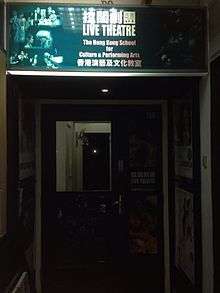Old industrial buildings revitalisation in Hong Kong
Old industrial buildings revitalisation is a project first proposed in the 2009-2010 Policy address of Hong Kong. It aims to redevelop unused and affordable industrial buildings into space for new businesses, especially for the "six pillar industries".[1][nb 1]




Objectives
The project has three main measures:
- Lower the ownership application threshold for compulsory sale for redevelopment from 90% to 80%.
- Give owners options to pay for the assessed land premium by financing at a fixed rate of 2% over five years.
- Create a tailor-made lease modification which provides land premium based on their most suitable use.[3]
The government continues to provide art space at favorable industrial premises. From 2010 to 2013, 13 applications for redevelopment and 49 for wholesale conversion have been approved and it has supplied about 680,000 square meters of non-industrial use area.[3]
Distribution and type of business
Industrial buildings are located broadly throughout Hong Kong and there are varying concentrations of types of businesses. The following are some examples of clustering:[4]
- Kwun Tong: movie post-production offices and music studios
- San Po Kong: performing arts stages
- Chai Wan: photo studios
- Fo Tan: visual arts studios
Other types of businesses include sports (e.g. skiing, snowboard, baseball, softball and football facilities), creative arts workshops (e.g. leather workshop, painting, sculpture, music), restaurants and farms (e.g. aquatic farm and hydroponics plantation).[5]
Impact
Positive impact
Providing land for various land uses
Considering that land space in Hong Kong is scarce in relation to its population, continuous development is needed to keep up with growth. To manage the need for commercial and residential space, old industrial buildings are being converted into offices, residential areas, hotels and other uses. This is also especially useful for cultural and creative industries that may require large commercial space. The Jockey Club Creative Arts Centre (JCCAC) is an example. The building renovated for JCCAC was a factory estate in Shek Kip Mei, which has been abandoned since the 1990s. It was converted into an arts centre for cultural development, and it has work space for more than 100 artists and arts groups.[6][7] Additionally, it is cheaper and fast to renovate old buildings is faster than constructing new ones.[8]
Minimising construction waste and costs
Revitalizing old industrial buildings prevents demolition, minimizing construction waste and land pollution.[8]
Negative impact
Increase in rental fee
The Policy of Revitalizing industrial buildings resulted in an increase in rental fees, increasing the rateable value 2% in 2012 and 7% in 2013.[9] A survey conducted in 2010 by the Hong Kong Arts Development Council (HKADC) showed that over 60% of industrial buildings users had problems as a result of rental increases.[10] The average increase was 14%. According to the recent survey proposed by HKADC, among 800 arts groups renting space in industrial buildings, 61.5% stated that they were facing an increase in rental fee, which poses a financial threat to arts groups who have unstable income. Their rental fee, including cost of installing air conditioners and other equipment, accounts, for the largest part of their expenses. Some arts groups or arts practitioners choose to relocate from the old industrial buildings as a result.
Limitations on current Land Use Policy
In accordance with the Hong Kong Development Bureau town planning laws, cultural and creative industries (e.g. information technology, design and media production office, audio-visual recording studio, etc.) are allowed in these two zones.[11] Nonetheless, Ms Leung Po Shan, the spokesperson of the Factory Artists Concern Group (FAC) stated that drama groups were not allowed to rent in factories.
See also
Notes
- Regarding the "six pillar industries", from Developing the Infrastructure for Economic Growth: Hong Kong enjoys clear advantages, namely, education services, medical services, testing and certification, innovation and technology, cultural and creative industries, and environmental industries.[2]
References
- "Policy Address 2009-2010 – Breaking New Ground Together"
- "Developing the Infrastructure for Economic Growth" (PDF). Hong Kong - Policy Address. p. 2. Retrieved 17 December 2013.
- "Revitalising Old Industrial Buildings" Archived 2013-12-17 at the Wayback Machine, Hong Kong Industrialist by Federation of Hong Kong Industries, 2009.
- (in Chinese) "我要做特首2 第97集 活化工廈", ATV. Retrieved on 6 November 2013
- (in Chinese) "廠出新天地 (information)", TVB
- (in Chinese) "綜合能力﹕活化工廈 推創意產業", Mingpao, Hong Kong, 29 March 2012. Retrieved on 3 November 2013.
- "About JCCAC"
- "Optimising the use of industrial buildings -Merits of redevelopment and wholesale conversion"
- (in Chinese) "工廈租金升 藝術家呻苦", Metropolis Daily, Hong Kong, 1 November 2013. Retrieved on 2 November 2013.
- "Survey on the Current Status of Industrial Buildings for Arts Activities and Future Demand 2010"
- "Optimising the use of industrial buildings-Wholesale Conversion FAQs"
External links
| Wikimedia Commons has media related to Industry buildings in Hong Kong. |